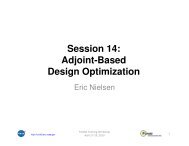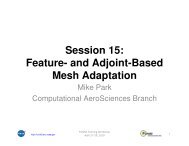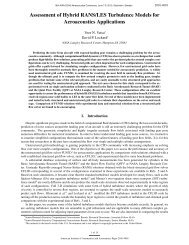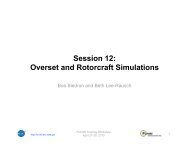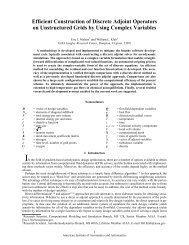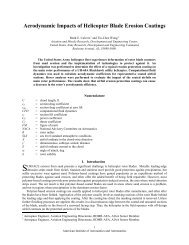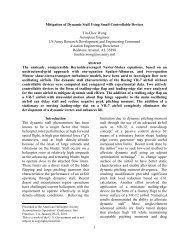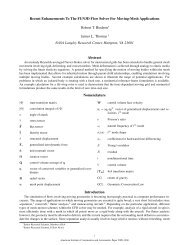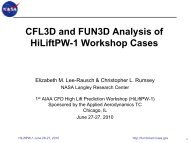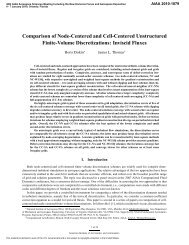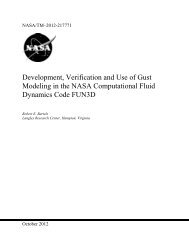Session 6: Supersonic/Hypersonic Perfect Gas Simulations - NASA
Session 6: Supersonic/Hypersonic Perfect Gas Simulations - NASA
Session 6: Supersonic/Hypersonic Perfect Gas Simulations - NASA
You also want an ePaper? Increase the reach of your titles
YUMPU automatically turns print PDFs into web optimized ePapers that Google loves.
<strong>Session</strong> 6:<strong>Supersonic</strong>/<strong>Hypersonic</strong> <strong>Perfect</strong> <strong>Gas</strong><strong>Simulations</strong>Bob Biedron(Jeff White and Mike Park)http://fun3d.larc.nasa.govFUN3D Training WorkshopJuly 20‐28, 20101
http://fun3d.larc.nasa.gov<strong>Session</strong> Overview• How to use FUN3D to compute supersonic and hypersonic flows- What are the challenges- List of inviscid flux types, their strengths and weaknesses- List of inviscid flux gradient limiter types, their strengths andweaknesses- Inviscid flux types and inviscid flux gradient limiters options thatwork the best for supersonic and hypersonic flows- Required practice for running adjoint based grid adaptation forsonic boom- Best practices for running supersonic and hypersonic flows- Example of a hypersonic flow application- What to do when things go wrong• We will not cover:- Theory/details of the inviscid flux construction- Theory/details of the inviscid flux gradient limiters• What should you already know- Physics of supersonic and hypersonic flowsFUN3D Training WorkshopJuly 20‐28, 2010 2
What Are the Challenges?• The inviscid terms can be discontinuous, i.e. when there are shocks– Strong shocks can cause difficulties in inviscid flux schemes especiallynear points in the flow where the dissipation vanishes. These are calledentropy problems.– Shocks cause discontinuities that make robust implementation of higherorder schemes difficult. This is called the monotonicty problem.• The inviscid terms can be a problem when there is strong expansion– Strong expansions can cause difficulties such that the local conditionsapproach a vacuum. This is called the positivity problem.– Strong expansions near the sonic point where dissipation due to the u-aeigenvalues vanishes can cause difficulties . This is called the sonicrarifaction or “expansion shock” problem.• There are a whole host of turbulence modeling challenges that arebeyond the scope of this presentation• We will concentrate on the inviscid terms in this presentationhttp://fun3d.larc.nasa.govFUN3D Training WorkshopJuly 20‐28, 2010 3
http://fun3d.larc.nasa.govInviscid Flux Types• Inviscid flux schemes fall into several categories :• Contact preserving, i.e. good for viscous flows• Flux difference splitting scheme of flux_construction = “roe”• Non positivity near vacuum conditions• The sonic rarefaction problem• The “carbuncle” problem• Non preservation of the total enthalpy in shocks• Entropy fixes exist for some but not all of these problems• Flux splitting schemes such as flux_construction = “hllc” and “ldfss” may displaysome limited unphysical behavior at very strong normal shocks• Non-contact preserving, i.e. not usually good for viscous flows• Flux vector split scheme, flux_construction =”vanleer”, has desirable qualities• Positivity near vacuum conditions• Preservation of the total enthalpy in shocks• Hybrid or “blended” schemes• The flux_construction = “dldfss” scheme is a blend of two schemes• The vanleer scheme at shocks via a shock detector• The ldfss scheme near walls via a shock and boundary layer detectorFUN3D Training WorkshopJuly 20‐28, 2010 4
Inviscid Flux Gradient Limiter Types• Gradient limiters are available in two types:• Edge based : limiting is done on an edge by edge basis,flux_limiter = “minmod”, “vanleer”, “vanalbada” and “smooth”• They are less dissipative and they work pretty well on hex grids butthey are not as robust on mixed element or tetrahedral grids.• They are not “freezable” and may cause convergence to get hung upby limiter cycling. They also can not be used when using the adjointsolvers• Stencil based : limiting is done based on the max and min reconstructedhigher order edge gradients that exist over the entire control volume“stencil”, flux_limiter = “barth”, “hvanleer”, “hvanalbada”, “hsmooth” and “venkat”• They are more robust but more dissipative and work on all grid types• They are “freezable”, i.e. they can be frozen after a suitable number ofiterations which sometimes will allow the solution to converge furtherand they must be used when solving adjoint equations• Limiters with the “h” prefix include a heuristic stencil based pressurelimiter to increase robustness and they also automatically activate thesupersonic_floors optionhttp://fun3d.larc.nasa.govFUN3D Training WorkshopJuly 20‐28, 2010 5
Calorically <strong>Perfect</strong> <strong>Supersonic</strong> flow• eqn_type = "cal_perf_compress"• Maximum Mach number in computational domain < 3.0 such that:• Shocks are relatively weak• Expansion fans are relatively weak• Inviscid flux options suitable for these applications:• When solving Euler eq. i.e. viscous_terms = “inviscid”• flux_construction = “vanleer”, “ldfss” or “hllc”• When solving Navier-Stokes eq.: viscous_terms = “laminar” or “turbulent”• flux_construction = “ldfss” or “hllc”• Inviscid flux gradient limiter options most suitable for these applications:• For applications that do not require solving the adjoint eq's.:• flux_limiter = “vanleer”, “vanalbada”“hvanleer” or “hvanalbada”• For applications that do require solving the adjoint eq's.:• flux_limiter = “hvanleer” or “hvanalbada”http://fun3d.larc.nasa.govFUN3D Training WorkshopJuly 20‐28, 2010 6
Calorically <strong>Perfect</strong> <strong>Hypersonic</strong> flow• eqn_type = "cal_perf_compress"• Maximum Mach number in computational domain 3.0 -> 10.0 suchthat:• Shocks may be strong, especially when there are normal shocks• Expansion fans may be strong• Inviscid flux options suitable for these applications:• When solving Euler eq. i.e. viscous_terms = “inviscid”• flux_construction = “vanleer” or “dldfss”• When solving Navier-Stokes eq.: viscous_terms = “laminar” or “turbulent”• flux_construction = “dldfss”• Inviscid flux gradient limiter options suitable for these applications:• For all applications:• flux_limiter = “hvanleer” or “hvanalbada”http://fun3d.larc.nasa.govFUN3D Training WorkshopJuly 20‐28, 2010 7
Running the Code: Best Practices• Applications with shocks and expansions may need to be run in 2steps. This is sometimes true for supersonic flow and almost alwaystrue for hypersonic flow.• Step 1 : Run solution first order while scheduling the CFL number toevolve the solution to a quasi-steady state;• first_order_iterations = xxxx, where xxxx is the same as the number ofiterations specified by steps = xxxx and• note that schedule_iterations = 1 yyyy should have yyyy < xxxx• schedule_cfl = 0.1dependentzz.00 where zz is a stable CFL number that is case• Step 2 : Restart solution higher order while scheduling the CFL numberto compute the final solution;• Read the restart file, i.e. restart_read = “on”• first_order_iterations = 0• schedule_cfl = 0.1 hh.00 where hh is a stable CFL number that is casedependent and will most likely be smaller than the CFL used in Step 1.http://fun3d.larc.nasa.govFUN3D Training WorkshopJuly 20‐28, 2010 8
Running the Code: Sonic Boom• Adjoint requires a frozen or differentiated limiter• Using cut cells• Cut cells permit a differentiated heuristic limiter• flux_limiter = “minmod” when –cut_cell• Aft-facing steps are an issue• --supersonic_floors clips low density and pressure• project.cutbc 3055 allows blowing• flux_construction = “vanleer”• Body fitted grids• --freeze_limiter at_this_iteration freezes limiter at this iteration• Requires a node-based “freezeable” limiterhttp://fun3d.larc.nasa.govFUN3D Training WorkshopJuly 20‐28, 2010 9
<strong>Supersonic</strong>/<strong>Hypersonic</strong>Retro-propulsion Flow Example• Turbulent retro-propulsion re-entry plume flow using grid adaptation• <strong>Supersonic</strong> free stream (Mach = 2.0) and• <strong>Hypersonic</strong> plume flow (Mach = 12.0)• Relevant namelist settings&code_run_control/steps = 7500restart_read = 'off'&inviscid_flux_method/first_order_iterations = 2500flux_limiter = 'hvanalbada'flux_construction = ’dldfss'&nonlinear_solver_parameters/schedule_iteration = 1 100schedule_cfl = 0.1 10.schedule_cflturb = 0.01 1.http://fun3d.larc.nasa.govFUN3D Training WorkshopJuly 20‐28, 2010 10
<strong>Supersonic</strong>/<strong>Hypersonic</strong>Retro-propulsion Flow Example• Residuals show continuity and energy eq. converged ~ 4 orders• Jet unsteadiness probably preventing convergence• Lift has converged, i.e. is no longer changing• Switch from 1 st order to 2 nd order scheme occurs at 2500 iterations• The hvanalbada limiter was frozen at 5000 iterations via thecommand line option --freeze_limiter 5000http://fun3d.larc.nasa.govFUN3D Training WorkshopJuly 20‐28, 2010 11
<strong>Supersonic</strong>/<strong>Hypersonic</strong>Retro-propulsion Flow ExampleSome Observations• Turbulent flow has made this case easier to run because of theadded dissipation caused by the eddy viscosity in the retropropulsionjet• If this case were laminar, it would probably be more difficult to run- You would need to be careful that the dldfss flux scheme doesnot add too much dissipation. However,• The careful use of feature based grid adaptation couldaddress this• The proper use of output based grid adaptation wouldautomatically address this- You would probably need to resort to the 2 step code runningapproach described earlierhttp://fun3d.larc.nasa.govFUN3D Training WorkshopJuly 20‐28, 2010 12
What To Do When Things Go Wrong• Try running the code 1 st order before switching to 2 nd order• Try running the code 1 st order longer before switching to 2 nd order• Try decreasing the CFL number• Try decreasing the number of linear sub-iterations• Check your grid resolution near the max. residual location– Under-resolved expansions can cause a lot of trouble– Really large grid aspect ratios near expansions can cause trouble• Check to make sure your boundary conditions are well posed. Thisis especially true for internal flowshttp://fun3d.larc.nasa.govFUN3D Training WorkshopJuly 20‐28, 2010 13
What We Learned• A little bit about flux schemes• A little bit about flux gradient limiters• Which flux schemes to use for supersonic flow• Which flux gradient limiters to use for supersonic flow• Which flux schemes to use for hypersonic flow• Which flux gradient limiters to use for hypersonic flow• Some best practices• What the convergence behavior may look like• What to do when things go wronghttp://fun3d.larc.nasa.govFUN3D Training WorkshopJuly 20‐28, 2010 14



